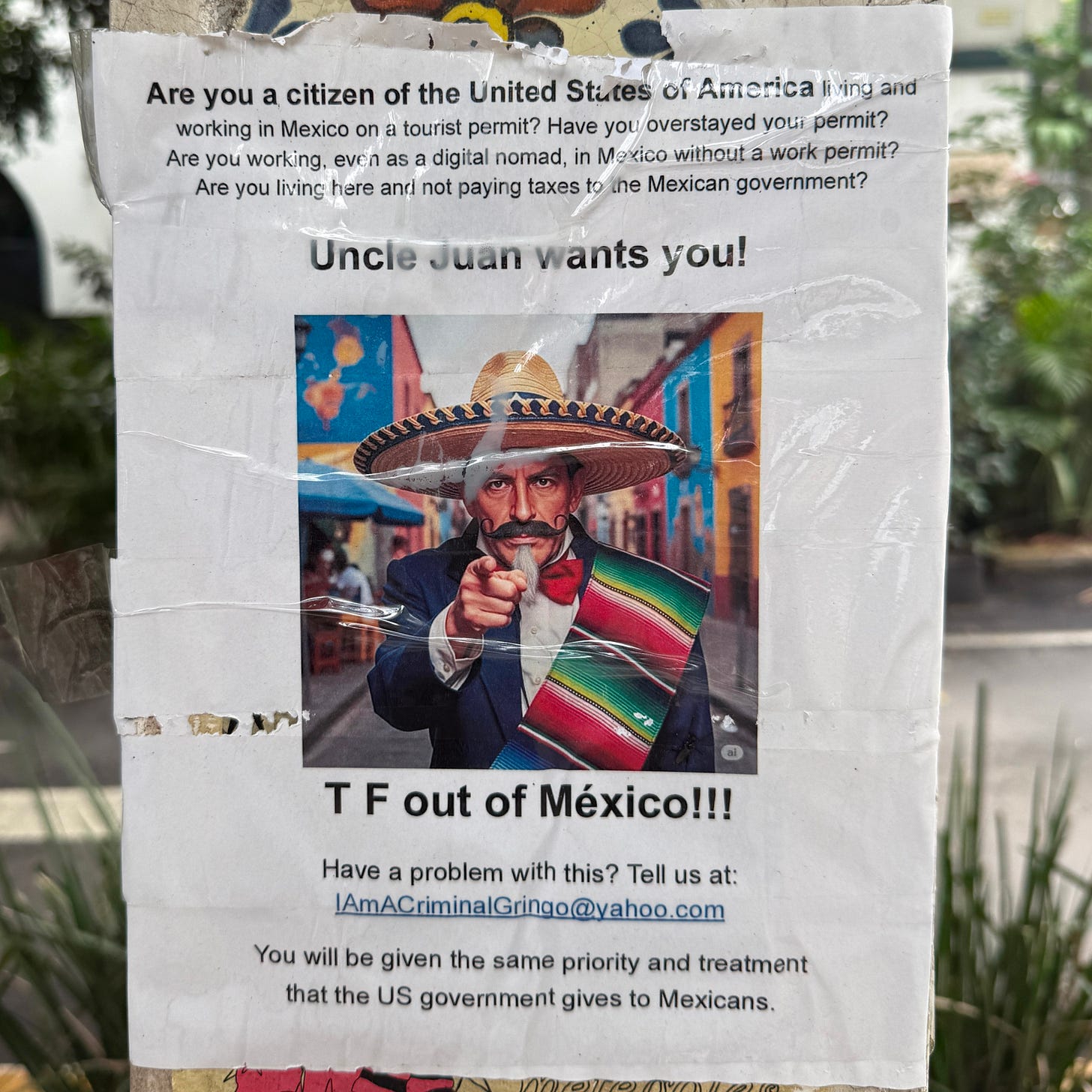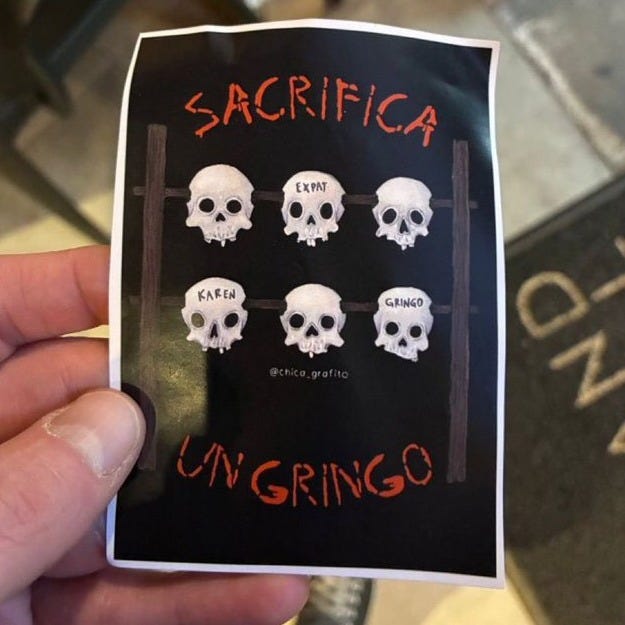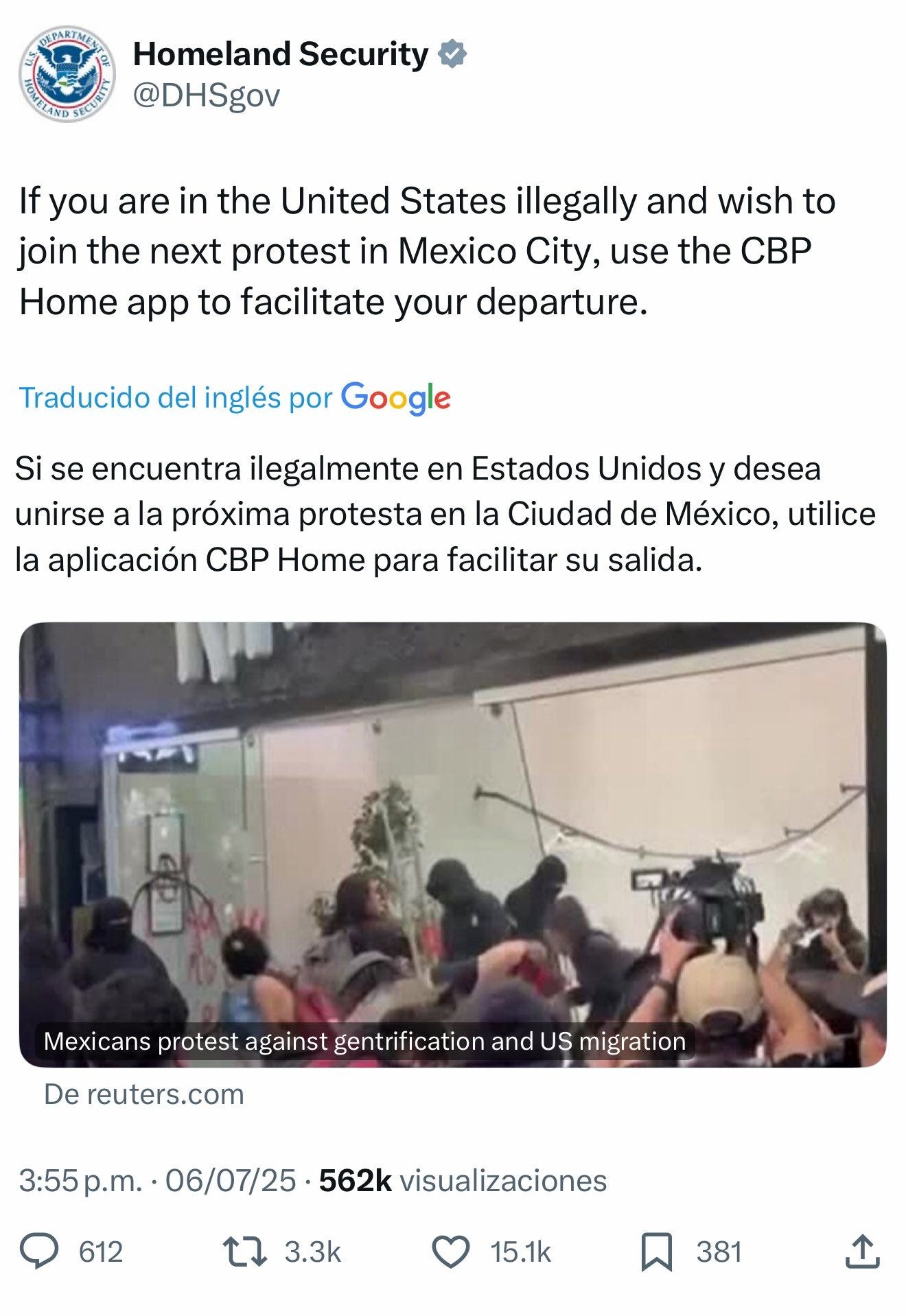Gringos Go Home! Interpreting Mexico City's Viral Gentrification Protests
Where they're right, where they're wrong -- and where they're going from here.
After a year-long hiatus, The Missive returns as a simmering debate over gentrification has erupted into open protest, viral outrage, and even violence. In a time of rising political tensions on both side of the border, it’s time for an update.
You’ve likely seen the viral images: locals chanting “Gringos Go Home!,” a burning effigy of Donald Trump, masked activists vandalizing businesses while bewildered tourists looked on. Parque México defaced with graffiti reading: “Tira Barrio y Lincha un Gringo” (“Defend your Barrio and Lynch a Gringo”).
International media framed the unrest as xenophobic backlash, while Mexican outlets emphasized legitimate grievances over displacement and housing. Social media amplified both extremes, prompting even the U.S. Department of Homeland Security to respond with a sardonic tweet:
This is something I noticed years ago, when I got my first Mexican troll on social media. The “go back to your country” rhetoric sounded a lot like the MAGA folks these activists purportedly oppose. Why is that? And what’s really going on?
That’s what The Missive is for. Let’s dive in.
A Quick Recap for New Readers
If you’re new here, here’s a primer on my previous coverage:
- Are Gringos Ruining Mexico City?: How pandemic-era remote workers transformed Roma and Condesa.
- How to Visit Mexico Mindfully: Practical advice for ethical tourism and policy recommendations.
- The Roaming 20s: How remote work reshapes global cities and creates new inequalities.
- Global Gentrification Series: A four-part debate with journalist Lauren Razavi on parallels with cities like Lisbon and Barcelona.
- Should Mexico Tax Digital Nomads?: Examining the economics and implications of taxing remote workers.
Rather than rehash my old articles, today I want to updates the conversation in light of the July 4th protests, Trump’s second term, and three years of close observation.
From Tourist to Tenant
I first came to Mexico City in 2016, when the tourism board hired me to help rebrand the capital from “DF” to “CDMX,” shedding its reputation for pollution and crime and promoting it as “The New Berlin.” Our series showcased the city’s incredible food, culture, and lifestyle to international audiences. Our campaign was part of a push that grew tourism 7.5% annually from 2016 to 2019 (DATATUR).
When the pandemic paused my travel career, I returned to CDMX to write my book. Condesa was empty; rents slashed 30%. I found an Art Deco apartment and over five years became a permanent resident, founding the city's first storytelling slam, Cuéntame. I immigrated and integrated into local culture as best I could.
Then this year, my landlord demanded a 25% rent increase over two years. I refused, citing Mexico City's rent control law capping increases at inflation (4.2%). After weeks of negotiation, the choice was stark: accept or leave. Laws are only as strong as their enforcement.
The Protest: Decoding the Slogans
Which brings us to the protests and their demands. Beyond the regrettable xenophobia are legitimate demands around issues affecting cities worldwide.
Let’s unpack the most common slogans from the rally:
“Aquí Se Habla Español” — Speak Spanish
- What’s True: Learning the language is basic respect. Too many expats never make the effort. This makes locals feel like foreigners in their own city.
- What’s Missing: Language is just the surface. True integration requires cultural engagement, not just linguistic competence. Personally, I’ve been pushing myself to attend live theater across the city, supporting the arts and immersing myself culturally.
“Gringos Fuera / Invasores” — Gringos Go Home / Invaders
- What’s True: The US took half of Mexico’s territory in 1848. This history remains present for Mexicans, while visitors are largely oblivious of the baggage they carry.
- What’s False: The math doesn't support an "invasion." Americans are less than 1% of CDMX’s population (~80,000), but they DO cluster primarily in Roma and Condesa, where foreigners can reach 15–20% (INEGI). This is still a drop in the ocean compared to places like Los Angeles, which is 39.7% foreign-born, mostly Latino. Mexico hosts 1.2 million immigrants in total (1% of the population); the U.S. hosts 11 million Mexicans alone.
- What’s Misunderstood: When neighborhoods transform to serve foreign tastes and budgets, even small percentages feel overwhelming. But protests conflate immigrants, nomads, and tourists—groups with very different impacts — while legal residents bear the brunt of the backlash.
- What’s Not Being Discussed: How social media algorithms funnel tourists and digital nomads into the same blocks, driving up rents and concentrating displacement. More on this in an upcoming article.
“¡Regulación Inmobiliaria Ya!” — Real Estate Regulation Now!
- What’s True: CDMX needs enforced rent control, limits on short-term rentals, and mechanisms to report violations anonymously (as in my case). Rents in Roma/Condesa have risen 35-50% since 2020.
- What’s Global: Tourism-fueled real estate speculation is happening worldwide. Lisbon rents are up 65% since 2015, with 25% of central housing now short-term rentals. Barcelona banned new Airbnb licenses in 2024. But the problem shows no sign of abating.
- What’s Complicated: Systemic corruption makes enforcement difficult—one of the biggest differences between CDMX and European cities.
“Vivienda Digna Para Los Mexicanos” — Dignified Housing for Mexicans
- What’s True: CDMX hasn’t built significant affordable housing since the 1990s. After both the 1985 earthquake, the government could have built affordable housing on damaged lots, but it didn’t. Millions commute hours to work each day.
- What’s Ignored: Housing prices have been rising for decades — long before digital nomads arrived. Mexican landlords and developers convert housing to Airbnbs and build luxury condos, often with little government oversight. Blaming foreigners is easier than confronting powerful Mexican interests.
“Gentrification is Not Progress, It’s Dispossession”
- What’s True: Mexicans have been gentrifying these neighborhoods for decades, but digital nomads accelerate displacement by favoring short-term rentals. Airbnb listings jumped from 5,000 in 2019 to over 35,000 in 2023, with 70% concentrated in three neighborhoods. Rents in Condesa have risen 35–50% since 2020, while average local salaries lag far behind.
- The “Progress”: Three years ago, then-Mayor Claudia Sheinbaum partnered with Airbnb to welcome digital nomads with open arms. She argued that if just 5% of the world’s 30 million nomads spend time in Mexico City, they would inject some US $1.4 billion into the local economy. Her partnership with Airbnb was specifically designed to move tourists out of Roma/Condesa while also restoring historic properties in the blighted colonial center. I thought this was good policy that could give Mexico’s historic center a much needed revitalization with UNESCO guiding the restorations.
The Result: Progress has been mixed. To be effective, the money generated from tourism should be diverted into building affordable housing and improving social services for the city’s most vulnerable. If buildings are converted into Airbnbs without adequate affordable housing, this results in dispossession and neocolonial dynamics.
“Pay Your Taxes”
- What’s True: Digital nomads pay no Mexican income tax, but this is not illegal. Current law only taxes wages earned from Mexican companies.
- What’s Complicated: Digital nomads bring $30 billion annually worldwide, but their spending inflates prices locals can’t match. Taxing nomads could wind up just pushing them elsewhere while leaving the damage done (see previous article here).
“Tira Barrio, Lincha un Gringo” — Defend Your Barrio, Lynch a Gringo
- What’s True: Violence is violence. Full stop. These threats mirror the same dehumanization Trump deploys against Mexicans, and play right into MAGA’s hands. See Trump’s DHS gleefully troll the protestors on X (below).
- What’s Happening: The escalation of these protests are a result of Trump’s extreme rhetoric and actions. ICE now has a budget bigger than most country’s militaries (including the IDF) and videos of families torn apart flood social media daily. When Mexicans watch their cousins brutalized in Los Angeles, their aunts deported from Chicago, or MAGA politicians joking about feeding latinos to gators at “Alligator Alcatraz,” rage builds. The cruelty is the point—and it's working both ways.
Moving Forward
I fear we’re seeing to be the “Horseshoe Theory” in action — when politics become so extreme that the far left- and far- right converge around nationalism, populism, and scapegoating outsiders for complex problems.
Many Americans in Mexico City came here fleeing Trumpism, who voted against walls, who believe in bridges. But instead of seeing us as potential allies in a push for sane immigration policies on both sides of the border, we’re being lumped with the very forces we both oppose while playing into Trump’s hands.
President Claudia Sheinbaum's response offers an example in leadership during polarized times. While Trump stokes division, she condemned xenophobia while acknowledging legitimate grievances: “The xenophobic displays seen at that protest have to be condemned. No one should be able to say ‘any nationality get out of our country’ even over a legitimate problem like gentrification.”
The question now is whether moderate voices can prevail over the extremes feeding off each other across borders. As Trump's deportation machine accelerates and Mexican resentment grows, the space for rational policy shrinks daily.
I’m excited to explore these themes in coming months. Broken windows can be fixed, but the broken systems remain. The Missive is a place to discuss solutions. Please share your thoughts in the comments below and subscribe to join the conversation.










It would be great to read a deep dive into the history of housing in Roma and Condesa. From what I’ve gathered (very sparingly, so please correct me if I’m wrong), these two neighborhoods were originally built for the wealthy. They then became more working class when the well-to-do people moved to other neighborhoods like Polanco after the earthquake in the 80s.
The reason I bring this up is not to dismiss the plight of affordable housing for middle and lower class Mexicans. It’s to raise the question of whether these neighborhoods are just in the part of a long-term housing cycle where the shift is back to the affluent.
Thank you for your comments and analysis. Yes: extremes touch each other. Let's hope that moderate voices prevail.
I respectfully disagree regarding our President's position: while her response regarding this issue has been more moderate, she has polarized Mexican society since the beginning of her term (as her predecessor did as well). The mayor of Cuauhtemoc, where Condesa is, belongs to an opposition party, so there might be some forces trying to make her look bad.